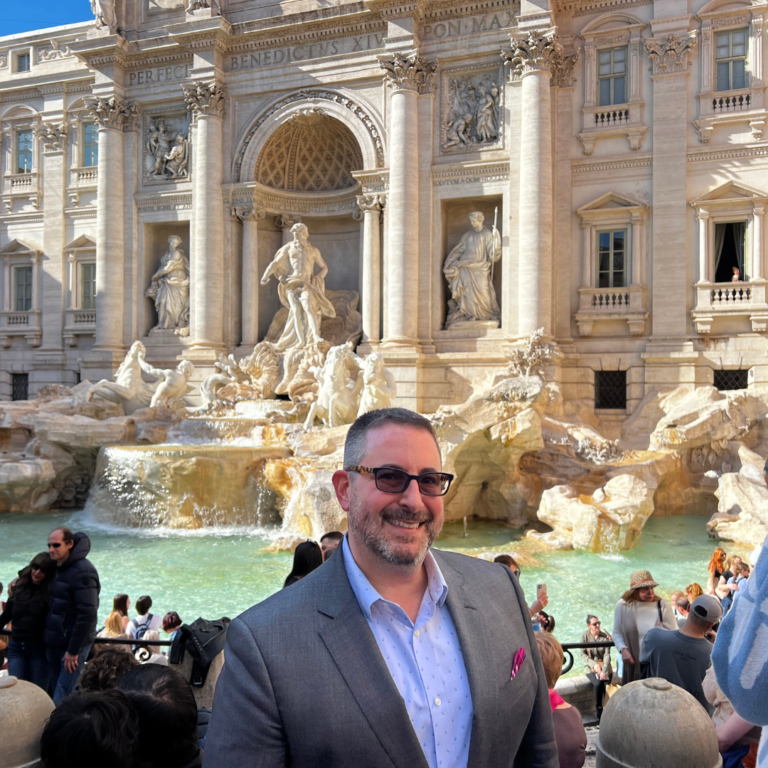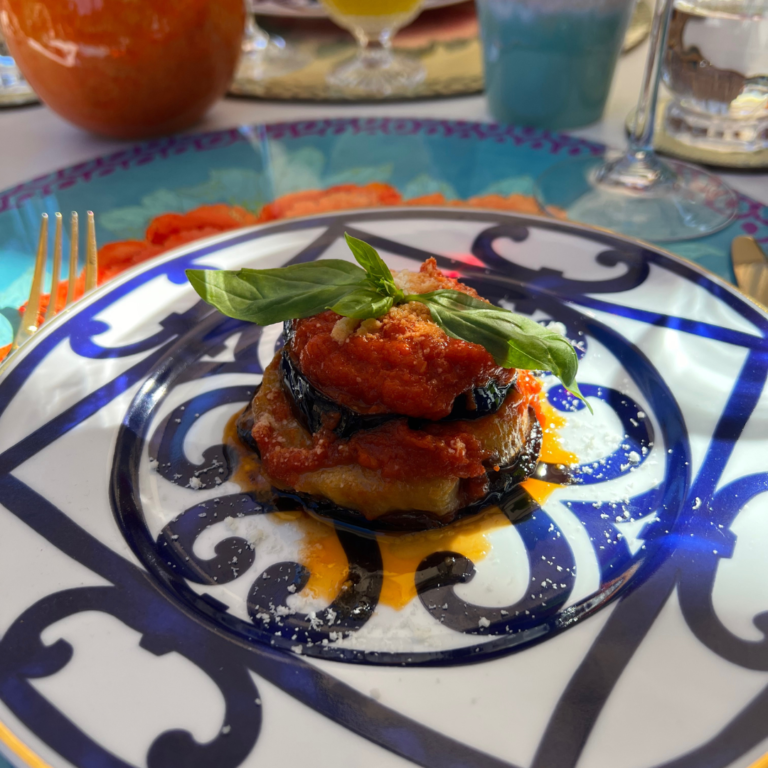After breakfast, I made my way to Napoli Centrale to board my train to Rome. I hadn’t been to Rome in almost nine years, and I knew that I couldn’t be a one-hour train ride away from The Eternal City and not have a carbonara in the motherland.
Since this was a business trip, I decided to schedule visits to two incredibly luxurious hotels in Rome—one on the boutique side of the luxury spectrum, the other on the world-famous brand side. I was able to connect with colleagues, take in some of Rome’s iconic sites, and of course enjoy one of Rome’s signature pasta dishes, a perfectly prepared carbonara.
WHAT TO EAT IN ROME – PASTA AND BEYOND
Clients frequently ask me where to get “the best” food in Italy, and my answer is always to find restaurants, trattorias, and osterias that serve dishes that are traditional in whichever region or city they are visiting. (Hint: lasagne is local to Bologna so it’s probably not going to be the best item on the menu in a Roman restaurant.)
In Rome, the local pasta specialties to try are carbonara, cacio e pepe, amatriciana, and alla gricia. There’s a lot of overlap in the ingredients used in these dishes. Three out of four (all but cacio e pepe) are made with guanciale, cured pork cheek which has a taste similar to bacon and pancetta. Many people will insist that pancetta and guanciale are “the same thing” (yikes!), but pancetta is made from pork belly (“la pancia”) while guanciale is made from pork check (“la guancia”). Sure, there are similarities, but real ones know the difference.
SPAGHETTI ALLA CARBONARA
Carbonara is made with the delicious, slightly crunchy and smokey guanciale, egg yolk, grated pecorino romano cheese, and lots of freshly ground black pepper, and is made creamy by adding the perfect amount of pasta water immediately before serving.
There is no cream in carbonara (read that again).
Carbonara is most often served with spaghetti, but one of my favorite restaurants in Rome serves it with rigatoni, which is the version of the dish I am constantly trying to perfect in my own kitchen (email me if you’d like to know which restaurant).
Generally speaking, if you are looking for the best of Roman cuisine, check out restaurants located in Testaccio or Trastevere, two of Rome’s more local neighborhoods.

In addition to trying these incredibly tasty pasta dishes that are unique to Rome, also keep an eye out for local dishes like coda alla vaccinara (stewed oxtail), abbacchio al forno (roast lamb, often served with roast potatoes), and carciofi alla romana, the local way of preparing whole artichokes and a must-try appetizer when artichokes are in season.
WHERE TO STAY IN ROME
Travelers visiting Rome for the first time (or second time, or third…) will likely want to include visits to the Pantheon, Trevi Fountain, Piazza Venezia, Spanish Steps, and Colosseum, so a hotel located in Rome’s historic center (Centro Storico) is likely going to be your best bet. Rome is a very walkable city and has an incredibly reliable metro system that is easy to use; just be prepared for some serious crowds during rush hour.
After arriving at Roma Termini train station, I made my way over to my first appointment. If you’re the type of traveler who prefers smaller, boutique luxury hotels that are centrally located and almost hidden in plain sight, Singer Palace Hotel is an excellent option in Rome’s historic center. The building is an excellent example of art-deco design in Rome, is the former site of Singer’s Rome headquarters (yes, the iconic sewing machine company), and has been a stylish, family-owned hotel since 2018.
After giving me a fantastic tour of the hotel and several of its rooms and suites, Federica (one of the hotel’s managers) and I had lunch at their fabulous rooftop restaurant. I had a delicious eggplant parmigiana as an appetizer and a carbonara that knocked my socks off, all while enjoying the most perfect view of Rome’s rooftops. We were even treated to a visit from one of the hotel’s owners, Michela, who I was delighted to see again (we had previously met last year at an industry event in Las Vegas).
After lunch, I had less than an hour to make my way over to my second appointment, but when I saw just how close I was to the Trevi Fountain, I decided to take a little detour to do some sightseeing (literally when in Rome…). In under five minutes, I was at the Trevi Fountain and found myself asking tourists from Wisconsin to take my photo (one of them joked about running off with my phone/camera; everyone’s a comic).
SITES TO SEE IN ROME
As I was leaving the Trevi Fountain to make my way over to my next appointment, I saw a sign pointing towards the Spanish Steps. I truly did NOT have enough time to make yet another stop, but when I realized that my next appointment was only two metro stops away from the nearby Spagna metro station, I shrugged and walked towards the Spanish Steps. Piazza di Spagna and the Spanish Steps are truly majestic sites, and I’m glad I made the time to pop over for a quick visit.
Thanks to the metro, I arrived at my next hotel visit, The St. Regis Rome, right on time. I had an appointment with Alessandro, who was incredibly friendly and showed me several rooms and suites, including the Royal Suite, which just might be the most insanely opulent hotel suite I’ve ever stepped foot in. This suite had a living room (with a grand piano), private dining room, small kitchen (for staff to prepare ensuite meals for guests), a private studio, and an incredibly large marble bathroom with two TVs (so you don’t have to turn your head to watch while in the bathtub, a huge inconvenience).
During our tour, Alessandro’s key did not successfully open one of the suites he planned on showing me, so he asked a colleague for assistance. The colleague told him in Italian (not knowing that I speak the language) that we would not be able to view this suite because it had already been prepared for an A-list actress who would be checking in later that day. Hotel management had assured her and her staff that nobody else would be entering the room before her after it had been prepared and they were 100% sticking to it (don’t ask me who it was, I’ll never tell).
After my visit was over, I walked to Rome’s main train station, Roma Termini, which was only about 10 minutes away on foot from The St. Regis Rome, to make my way back to Naples for the conference’s welcome dinner.
TAKING THE TRAIN IN ITALY
One of my favorite things about visiting Italy (and Europe in general) is the ease of getting from city to city using the train system. Italy has several high-speed and regional train companies that locals and travelers alike use to get all over the country without having to deal with the added hassle of going all the way to the airport. The convenience of going from the center of one city to the center of another is unmatched, and I truly wish it was something we could rely on more here in the U.S.
HOW TO BUY TRAIN TICKETS
If you are buying tickets in advance (which I highly recommend doing), one of the easiest ways to do so is by using Trainline. Within the app (or on their website), you’re able to select your starting point, destination, time and date of departure, class of service, number of travelers, etc., and purchase your tickets directly in the app. They are then emailed as a PDF and stored in the app, making it incredibly easy to access them when you need to. Be aware that train tickets are usually only available for purchase a few months in advance, so you may have to wait for dates further out to become bookable.
You are also able to purchase paper tickets at the station but be aware that paper tickets will usually need to be validated manually on the train platform. There are small machines you can use to validate tickets simply by inserting your train ticket to allow it to get stamped. If you board the train with a paper ticket that has not been validated, you may be subject to paying a hefty fine—a ticket that has not been validated could in theory be used a second time. Digital tickets purchased in advance that are only valid at the time and date listed on the ticket do not need to be validated manually.



HOW TO TAKE THE TRAIN FROM ROME
Once you’ve purchased your tickets, you’ll be able to see the departure date and time, the origin and destination, and train number on your ticket. When you arrive at the train station, look up! There will be a huge board (and several smaller boards throughout the station) that lists every arrival and departure that is happening within the next couple of hours at the station.
Once you’ve found your train number and departure time on the board, look for the “binario” column to see what platform or track number your train will be departing from (“binario” is singular while “binari” is plural). If you find your train on the board but see a blank space in that column, don’t worry. It is very common for platform numbers to be announced only a few minutes before your departure time, so once your platform number pops on the board, make your way to the platform.
You also may notice the words “carrozza” and “sedia” on your ticket, which lets you know your passenger car number (look for signs on the train platform) and seat number, respectively, once you’ve boarded the correct car.



After settling in on the train, I had a little over an hour to relax and take in the incredible day I’d had exploring Rome both as a traveler and travel business owner. The conference was set to begin the following morning, and I knew I had a full two days of work ahead of me. Following the conference, I got to spend one final day in Italy, this time on the beautiful island of Ischia, located in the Bay of Naples.
Stay tuned for my next blog post—the final one in this series—which is going to give you lots of insight into Ischia and all there is to do on this beautiful and rustic island.
















